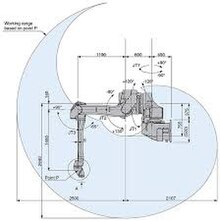| Part of a series on |
| Automation |
|---|
| Automation in general |
| Robotics and robots |
| Impact of automation |
| Trade shows and awards |


Industrial paint robots have been used for decades in automotive paint applications.
Early paint robots were hydraulic versions, which are still in use today but are of inferior quality and safety to the latest electronic offerings.[1][2][3] The newest robots are accurate and deliver results with uniform film builds and exact thicknesses.
Originally, industrial paint robots were large and expensive, but robot prices have come down to the point that general industry can now afford the same level of automation used by the large automotive manufacturers.
The selection of modern paint robot varies much more in size and payload to allow many configurations for painting items of all sizes.
Painting robots generally have five or six axis motion, three for the base motions and up to three for applicator orientation. These robots can be used in any explosion hazard Class 1 Division 1 environment.
Industrial paint robots are designed to help standardize the distance and path the automatic sprayer takes, thus eliminating the risk of human error caused by manual spraying. Paint robots are often paired with other automatic painting equipment to maximize the efficiency and consistency of the paint finish. Rotational Bell atomizers, other automatic electrostatic or automatic conventional sprayers are mounted on the robot to provide the highest quality finish. Automatic mixing equipment will usually supply the sprayers with paint. This equipment is designed to regulate pressure and flow, which are extremely important in providing consistent paint finish. Varying levels of automatic mixing equipment can also provide features that cut down on paint waste, and energy costs.
- ^ "abb.com" (PDF). Archived from the original (PDF) on 2018-07-13. Retrieved 2016-08-30.
- ^ "Robotics Online". Robotics Online.
- ^ Rola, Martin D. "Robotic Painting". www.pfonline.com.